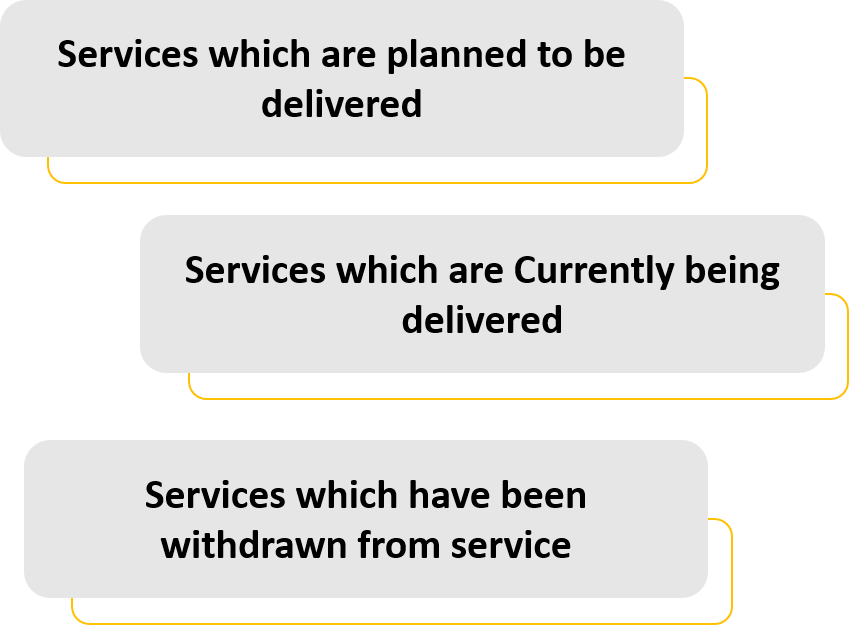
Service portfolio management is the governance process of the service portfolio. The process is one by which a service provider can manage their investments across the service lifecycle by taking into account every service in terms of the business value provided by it.
A service provider makes use of service portfolio management to control the entry of any service into the service portfolio by tracking any investment in services through its entire lifecycle starting from the development to the delivery and retirement stages.
Purpose of Service Portfolio Management
- The main purpose of service portfolio management is to make sure that the service provider has a proper mix of services to meet their overall service strategy.
- Service portfolio management ensures that the entry or exit of service from any stage is dependent on the approval of funding. It also required an appropriate financial plan to recover the costs or to generate a required level of profit, depending on the nature of the service provider’s organization.
The Objective of Service Portfolio Management
The objectives of service portfolio management are:
- To enable a service provider to investigate and make decisions regarding which services need to be provided and which of them need to be retired. This is based on risk analysis and the potential return which can be obtained.
- To document every service planned and operated by the service provider for future reference.
- To manage a definite service portfolio that includes a clear articulation of the business needs that are addressed by each service and the business needs it supports.
- To run every new service through a set of activities and procedures which are standardized to ensure that the relevant information for management, service delivery, and support is documented and provided to the appropriate management processes.
- To evaluate the degree to which each and every service of theirs enables the service provider to achieve their service strategy.
- To control the services being offered under different conditions and investments.
- To review each service under the Continual Service Improvement Process.
- To provide an information base for a service catalog through the service portfolio.
- To track every investment in service throughout each service’s lifecycle.
Scope of Service Portfolio Management
The scope of service portfolio management encompasses the following:
For an internal service provider, their execution of service portfolio management requires them to work closely with each business unit in the organization to assess the service investment and returns.
For an external service provider, their execution of service portfolio management required them to be able to evaluate each service more overtly as each service should generate profit directly or support the services which are generating profit.
Portfolio Management Roles and Functions
Static Process Roles
- Service Portfolio Process Manager
The service portfolio process manager has to manage the entire process and is responsible for its effectiveness and efficiency. - Service Portfolio Process Owner
The service portfolio process owner is the process initiator and is accountable for defining the strategic goals of the process and allocating all the resources required for the process - Service Portfolio Management Team
The service portfolio management team is the team associated with the service portfolio management process.
Dynamic Process Roles
- Service Agent
The Service Agent attribute of each service record consists of the role which is responsible for the present activity within the process of Service Portfolio Management. The Service Agent can be changed by a functional escalation if the rules permit it. - Service Owner
The Service Owner attribute of each service record consists of the role which is presently accountable for the service. - Service Sponsor
The Service Sponsor is the person or board responsible for the budget and specific costs related to the service. - Requirements Requestor
The requirements requestor consists of a person or a group of people who are expressing the new demands which need to be fulfilled by the IT service provider. - Service Design Team
The service design team is the one associated with all the tasks in the context of designing a service.
Portfolio Management Value
The following benefits are offered by Service Portfolio Management:
- It allows the business to make the right decisions with regard to investment and de-investment in services, thus ensuring that such decisions are made on the basis of a strong business case.
- The portfolio management provides a meaningful and cost-effective alignment between the IT services and strategic goals for the business.
- It provides a shift in attitude toward IT, which is now viewed as a value-generating component instead of being considered an inevitable expense.
- It leads to an increase in the ability of the company to cater to the end-users.
- The organization is provided with an insight into the difference that the IT service would create and the impact it would have on the business.
- It helps to give increased attention and focus to the services which are the most valuable and profitable, thereby increasing the productivity of employees.
Portfolio Management Principles
The main principle of service portfolio management is to enable a service provider to understand the following:
- The services provided by service portfolio management
- The investments made in those services
- The strategy and objectives of each service in terms of business value.
With this understanding, the service provider can control and management decisions about its service throughout the service lifecycle.
Service Portfolio Management Process Activities
There are 4 major phases of activity in service portfolio management:
- Define
This phase involves the collection and validation of the entire inventory consisting of all the existing and proposed services, including their business cases. - Analyze
During the analyzing phase, the services which are required for the service provider to achieve its strategy are identified. In addition to that, identification of how well the existing service portfolio meets these and how to prioritize and balance supply and demand is also made. - Approve
Each service in the service portfolio along with the level of investment associated with it needs to be approved. All changes made to services in the service portfolio also need approval. Even when services are being retired, approval is required. - Charter
In order to authorize each project to build, enhance or retire a service, a charter is required. The purpose of the charter is to document the scope of the project and the terms of reference in addition to the approval decisions related to agreed changes to the service portfolio.
Service Portfolio Management Risks & Challenges
The following challenges can be encountered by service portfolio management:
- A lack of access to information is required for business.
- Absence of formal project management or change management.
- A service portfolio that is focused only on the service provider’s aspect of its services.
- Absence of a project or customer portfolio.
Some of the risks faced are as follows:
- Customer pressure can lead to ill-informed decisions regarding which services to offer and invest in.
- The services being offered cannot be measured adequately.
Conclusion
Overall the service portfolio management ensures enterprises take correct decisions in the form of investment, justifying the business case, and having a clear understanding of expected ROI. Service portfolio management analyzes all the critical aspects required to provide high-quality IT services to the customers and the investments required to build, operate and deliver the same. Give yourself a chance to grow in your Service Management career with the ITIL 4 Foundation certification training, and gain useful skills and best practices.
Know more about Service Management best practices through Invensis Learning’s IT Service Management certification training on ITIL 4 Foundation Online, SIAM Foundation, SIAM professional, VeriSM, etc.
















